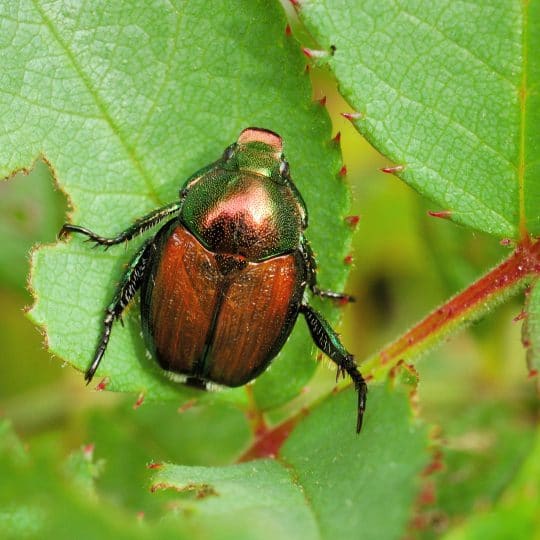Facts about Japanese Beetles
How to Identify, Control, and Prevent these Pests
Posted
May 24, 2018

They may be small, but Japanese beetles can cause a lot of damage to your plants and trees. Find out more about these beastly insects and what you can do to help save your yard.
What are Japanese Beetles
About half inch in length with blue-green heads, copper backs, and tan wings, these beetles may be small bugs, but they have a large appetite. Not considered picky eaters, Japanese beetles favor over 200 species of plants, but they prefer roses, beans, grapes, and raspberries. Once they’re done eating, only the skeletonized veins of a leaf are left. These pests don’t like to eat alone either, so if you see one, chances are its buddies are close. This makes them one of the biggest threats to crops across the Eastern and Midwest of the U.S.
Here’s a timeline of their lifespan:
- They lay eggs in the soil around June.
- Eggs develop into tiny white grubs that lay low for about 10 months, overwintering in the soil.
- Adult beetles emerge from soil and begin feeding in June.
- The lifecycle of an adult Japanese beetle is about 40 days.
Controlling Japanese Beetles
There are many ways homeowners and farmers have tried to prevent and control Japanese beetles from ruining plants. Here are just a few of the most popular:
- Hand pick them off your plants and put them in a solution of a tablespoon of liquid dishwashing detergent and water, which will cause them to drown.
- Use a shop vac to suck them off plants and then dump them into a soapy solution.
- Cover your plants during the six to eight week beetle feeding period in early summer.
- Put down a dropcloth overnight, and in the early morning, when they’re most active, shake them off into a bucket of soapy water.
- Insecticides can work, but instructions must be followed closely.
- Apply any sprays in the morning, but not in full sun or hot temperatures. If your plants start to wilt, rinse the leaves immediately with clean water.
- Japanese beetle traps can be helpful in some instances, but they also might attract more beetles from beyond your yard. Be sure to place traps far away from plants you want to save.
- Apply diatomaceous earth, a powder you can dust your plants with. It is not a poison, but an irritant to the bugs. It works its way into their exoskeletons and kills them.
- Eliminate them in the grub stage—late spring and fall. Spray the lawn with a mixture of two tablespoons of liquid dishwashing soap diluted in one gallon of water per 1,000 square feet. The grubs will surface and the birds will feast. Spray once each week until no more grubs surface.
Preventing Japanese Beetles
Maintaining a healthy lawn, trees, and plants by watering and fertilizing regularly is one way to help reduce the damage caused by beetles. Remove any dead or diseased plants, which can attract Japanese beetles.
You can also introduce the fungal disease milky spore into your lawn to control the beetle larvae population. The larvae ingest the spores as they feed in the soil. This fairly expensive method could take a few years to become effective.
Planting garlic, rue, or tansy near your affected plants helps deter beetles in a more natural way. If you’re looking for more tips to tackle the beetle population in your yard, contact Elite Tree Care.